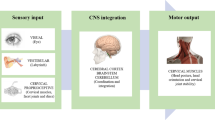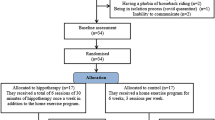Abstract
Some studies show that sensorial rehabilitation is effective on functionality. The aim of this study is to investigate the effect of sensory training of the posterior thigh on the functionality of upper extremity and trunk control in stroke patients. Thirteen subjects (53.23 ± 6.82 years) were included in the intervention group and 13 subjects (58.69 ± 5.94 years) in the control group. The control and intervention groups were treated for ten sessions. The control group was treated only with neurodevelopmental treatment, and the intervention group was treated with sensorial training on the posterior thigh in addition to the neurodevelopmental treatment. Subjects were evaluated three times, pre- and post-treatment and 10 days after finishing the treatment. Trunk control was assessed by the Trunk Impairment Scale, reaching function by the Functional Reach Test, balance by the Berg Balance Test, upper extremity symptom and disability severity by the Disabilities of the Arm, Shoulder, Hand and Minnesota, independence level in daily living activities by the Barthel Index, and sensory function of the posterior thigh by sensorial tests. In the post-treatment assessment, it was found that the intervention group was better than the control group in the parameter of functional reach while sitting (p < 0.005). In the third assessment, reaching while sitting and independence level were better in the intervention group than the control group (p < 0.005). There was no difference in sensorial assessment between the groups. Sensory training of the posterior thigh should be included in the rehabilitation programme of stroke patients.
Similar content being viewed by others
References
Carey LM (1995) Somatosensory loss after stroke. Crit Rev Phys Rehabil Med 7:51–91
Winward CE, Halligan PW, Wade DT (1999) Current practice and clinical relevance of somatosensory assessment after stroke. Clin Rehabil 13:48–55
Schabrun SM, Hillier S (2009) Evidence for the retraining of sensation after stroke: a systematic review. Clin Rehabil 23:27
Lennon S, Ashburn A (2000) The Bobath concept for stroke patients, disability and rehabilitation. Disabil Rehabil 22(15):665–674
Kılınç M, Avcu F, Onursal O, Ayvat E, Savcun Demirci C, Aksu Yildirim S (2016) The effects of Bobath-based trunk exercises on trunk control, functional capacity, balance, and gait: a pilot randomized controlled trial. Top Stroke Rehabil 23(1):50–58
Sullivan JE, Hedman LD (2008) Sensory dysfunction following stroke: incidence, significance, examination, and intervention. Top Stroke Rehabil 15(3):200–217
Doyle SD, Bennett S, Dudgeon B (2014) Upper limb post-stroke sensory impairments: the survivor’s experience. Disabil Rehabil 36(12):993–1000
Taub E (1980) Somatosensory deafferentation research with monkeys: implications for rehabilitation medicine. In: Ince LP (ed) Behavioral psychology in rehabilitation medicine: clinical applications. William & Wilkins, Baltimore, pp 371–401
Smania N, Montagnana B, Faccioli S, Fiaschi A, Aglioti SA (2003) Rehabilitation of somatic sensation and related deficit of motor control in patients with pure sensory stroke. Arch Phys Med Rehabil 84:1692–1702
Carey LM, Matyas TA, Oke LE (1993) Sensory loss in stroke patients: effective training of tactile and proprioceptive discrimination. Arch Phys Med Rehabil 74:602–611
Yekutiel M, Guttman E (1993) A controlled trial of the retraining of the sensory function of the hand in stroke patients. J Neurol Neurosurg Psychiatry 56:241–244
Lynch EA, Hillier SL, Stiller K, Rachel R, Campanella RR, Fisher PH (2007) Sensory retraining of the lower limb after acute stroke: a randomized controlled pilot trial. Arch Phys Med Rehabil 88(9):1101–1107
Niam S, Cheung W, Sullivan PE, Kent S, Gu X (1999) Balance and physical impairments after stroke. Arch Phys Med Rehabil 80:1227–1233
Hsu AL, Tang PF, Jan MH (2003) Analysis of impairments influencing gait velocity and asymmetry of hemiplegic patients after mild to moderate stroke. Arch Phys Med Rehabil 84:1185–1193
Nadeau S, Arsenault AB, Gravel D, Bourbonnais D (1999) Analysis of the clinical factors determining natural and maximal gait speeds in adults with a stroke. Am J Phys Med Rehabil 78:123–130
Wrisley DM, Whitney SL (2004) The effect of foot position on the modified clinical test of sensory interaction and balance. Arch Phys Med Rehabil 85(2):335–338
Dean C, Shepherd RB, Roger D, Adams S (1999) Sitting balance II: reach direction and thigh support affect the contribution of the lower limbs when reaching beyond arm’s length in sitting. Gait Posture 10:147–153
Dellon AL, Mackinnon SE, Crosby PM (1987) Reliability of two-point discrimination measurements. J Hand Surg Am 12(5 Pt 1):693–696
Bronstein AM, Brandt T, Woollacott M (2004) Clinical disorders of balance, posture and gait, 2nd edn. Hodder Arnold Publication, London
Shumway-Cook A, Woollacott M (2012) Motor control: translating research into clinical practice, 4th edn. Lippincott Williams & Wilkins, Philadelphia, p 641
Magnusson M, Johansson K, Johansson BB (1994) Sensory stimulation promotes normalization of postural control after stroke. Am Heart Assoc 25:1176–1180
Teyssedre C, Zattara M, Lino F, Bouisset S (1993) Does postural muscular activity associated with a pointing task depend on handedness? In: Proceedings of the XIVth International Society of Biomechanics conference, Paris, pp 1332–1333
Lino F, Bouisset S (1993) Is velocity of pointing movement performed in a sitting posture increased by upper body instability? In: Proceedings of the XIVth International Society of Biomechanics conference, Paris, pp 802–803
Morioka S, Yagi F (2003) Effects of perceptual learning exercises on standing balance using a hardness discrimination task in hemiplegic patients following stroke: a randomized controlled pilot trial. Clin Rehabil 17:600–607
Ruch TC, Fulton JF, German WJ (1938) Sensory discrimination in monkeys, chimpanzee, and man after lesions of parietal lobe. Arch Neurol Psychiatry 39:919–938
Author information
Authors and Affiliations
Corresponding author
Ethics declarations
Conflict of interest
There is no conflict of interest or funding.
Rights and permissions
About this article
Cite this article
Dogru Huzmeli, E., Yildirim, S.A. & Kilinc, M. Effect of sensory training of the posterior thigh on trunk control and upper extremity functions in stroke patients. Neurol Sci 38, 651–657 (2017). https://doi.org/10.1007/s10072-017-2822-z
Received:
Accepted:
Published:
Issue Date:
DOI: https://doi.org/10.1007/s10072-017-2822-z




